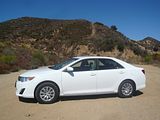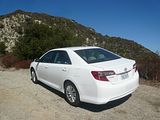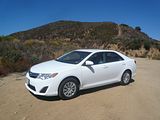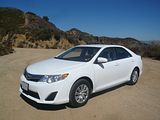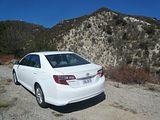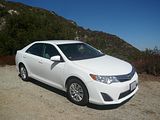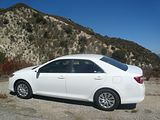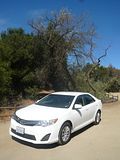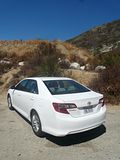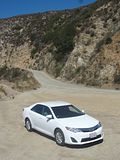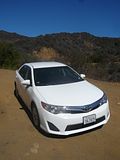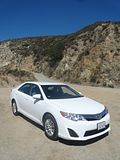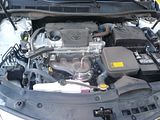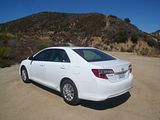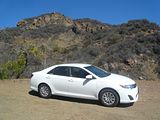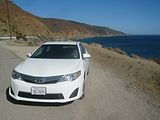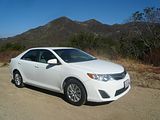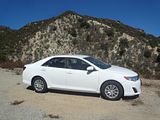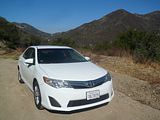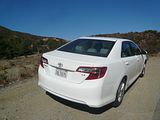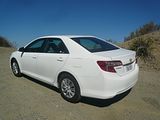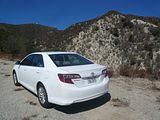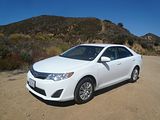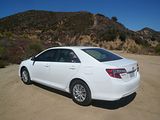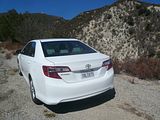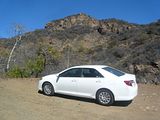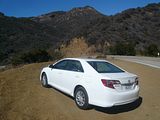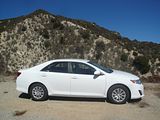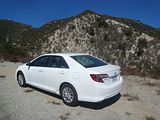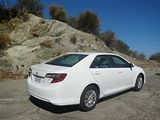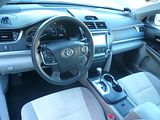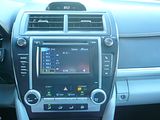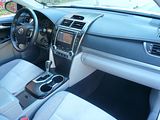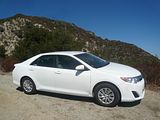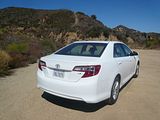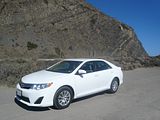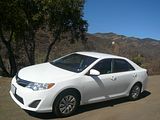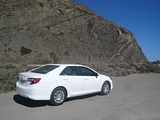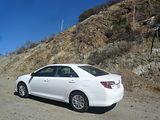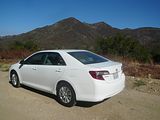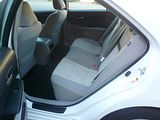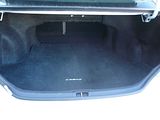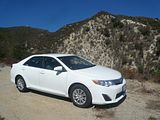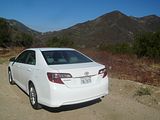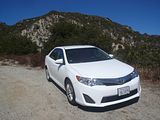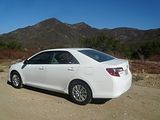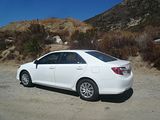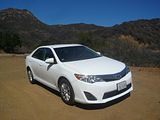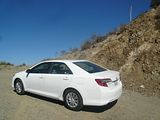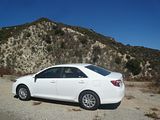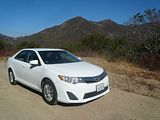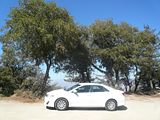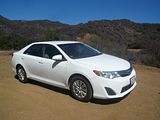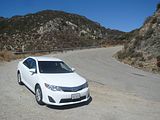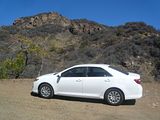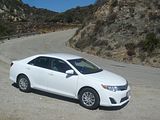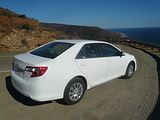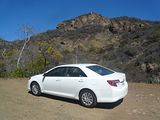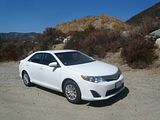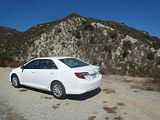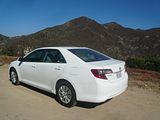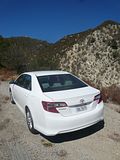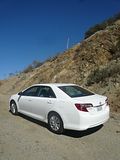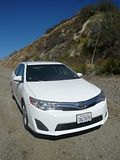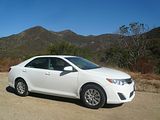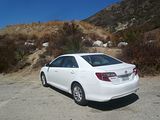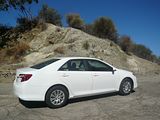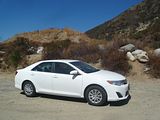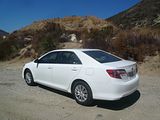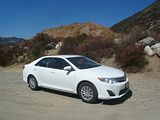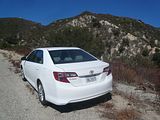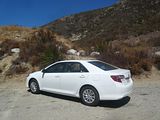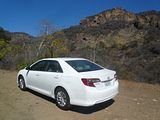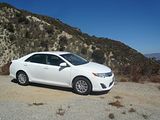
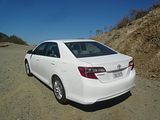
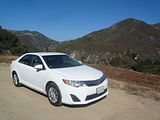


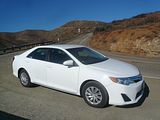
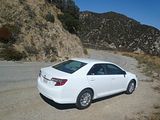
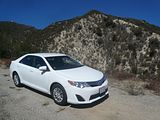
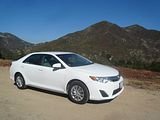
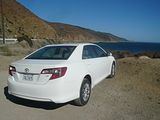
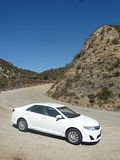
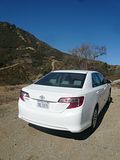
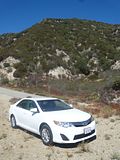
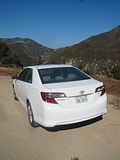


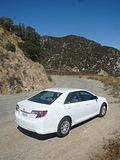
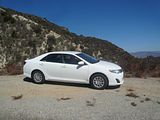
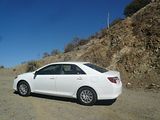
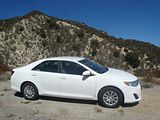
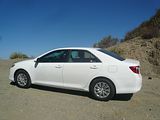
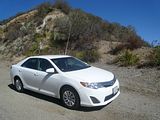
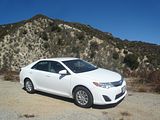

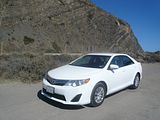
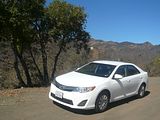
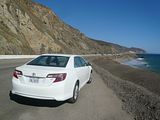
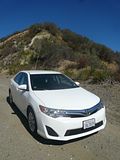
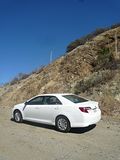
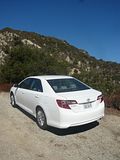
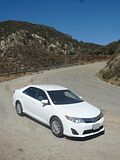
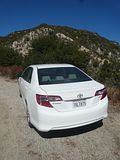
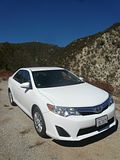
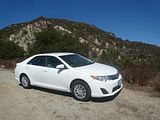
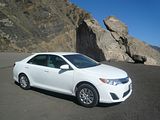
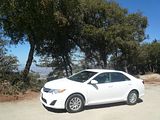
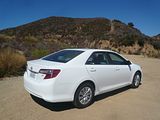
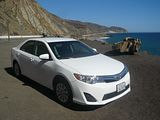

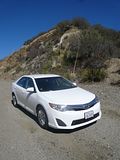

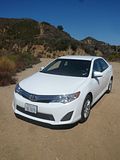
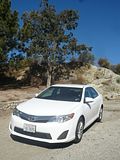

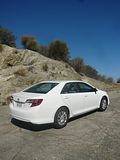
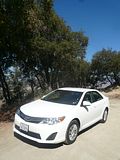
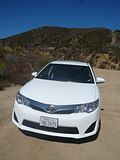
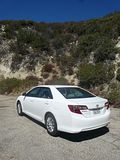
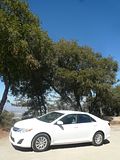

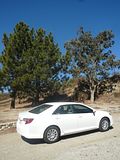
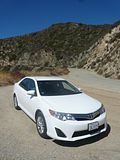
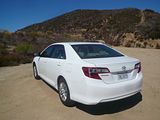
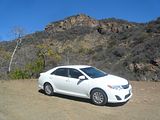
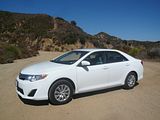

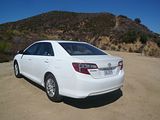

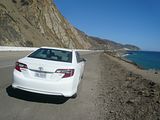
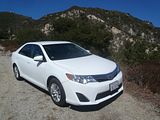
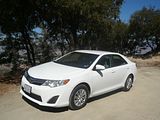
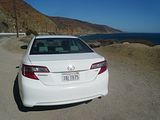

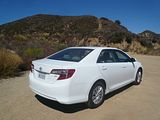
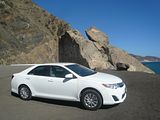
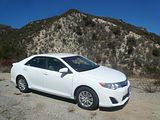
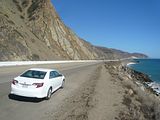
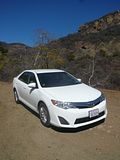
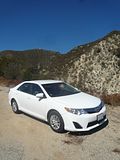
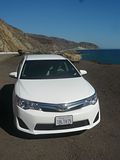
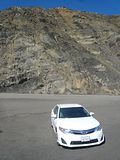
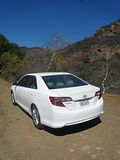

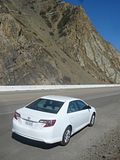
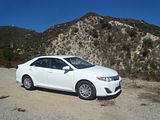
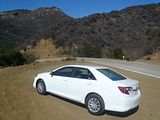
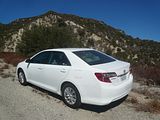

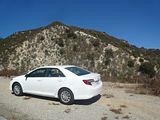
The latest generation of Camry rivals have largely foresaken the 3.something litre V6 engine options that they all used to have, as although these meant that the cars scored well in performance tests, very few were ever bought compared to the volume 2.4/2.5 litre 4 cylinder models. Toyota surprised everyone by continuing to offer a 3.5 litre V6 in this generation of Camry. With 268bhp and 248 lb/ft of torque, by all accounts it is a very brisk car, but needless to say, these do not appear in the rental fleets, so I will take others’ words on this point. There is also a 2.5 litre 4 cylinder Hybrid model available, which generates 200 bhp. Whereas some of the previous generation of these used to be in the rental fleets, none of the current ones seem to be, so that left me with the commercially most significant powerplant in my test car, a 2.5 litre 4 cylinder petrol engine which generates a class average 178 bhp and 170 lb/ft of torque. This is a slight increase on the power that was delivered in the last generation car, but, frankly, you won’t notice. All Camry models now come only with a six speed automatic gearbox, no manual is offered. On setting off from the Hertz facility, and heading towards the 405 freeway, destination canyon roads, my first impressions were that this car is indeed quiet.
Later in the day, on similar roads but devoid of traffic, I even wrote down the word “serene” to describe the cruising experience, but sadly, I also wrote down “utterly anaesthetised driving experience”. And that remains my over-riding impression of this car. The biggest culprit is the steering, which is far too light and vague feeling, especially when close to dead centre. Granted, it is not as bad as that in the last Corolla I drove, which convinced me that the steering wheel was simply connected to a bowl of fresh air, but to all intents and purposes here, it was largely devoid of any sensation. To make matters worse, the plastic steering was particularly unpleasant to hold, and had an odd moulding on the sides which was presumably designed to support your thumbs and fingers in the correct 10 to 2 driving position, but which I thought made it worse than an completely regular, unshaped wheel would have been. In the LE at least, the suspension is also very soft, so whilst this gives the Toyota a comfortable ride even on some of the less than well surfaced Southern California roads, it means that there is not an ounce of fun to be had with this car on the roads in the hills up above Los Angeles where, in the right car, you can entertain yourself on a mix of swooping bends and tighter turns. Although the 4 cylinder Camry is 20 bhp down on the equivalent Optima, and a few bhp short of some of its other rivals, it does not feel particularly lacking in the straight horsepower stakes. and even on the steeper inclines, there was plenty of oomph available without you getting the feeling that engine was having to work particularly hard. When bursts of acceleration were required on the freeway, again, this was not a problem and the Toyota’s gearbox made a very smooth downchange if necessary – often it was not – and the Camry gained the extra speed that your right foot had requested. The gearbox was very smooth in operation, except when the car was stationary, in Park and you pulled the lever back, when, no matter how gently I moved it, there was quite a “clunk” sound that was uncharacteristic of how everything else operated on the car. Even in conventional, non-Hybrid guise, the Camry is usually praised for delivering excellent levels of fuel economy, so my result from 180 test miles, of 26.47 mpg US, or 31.62 mpg Imperial, looks rather disappointing, as this is a lot less than I achieved with the Nissan Altima, the other car whose parsimony is often singled out. Worth mentioning, only for completeness, but not because they were in any way noteworthy were that neither the brakes nor the visibility gave any concerns, being perfectly acceptable.
Much was made of the revised interior on this “XV50” generation of the Camry, it being described as more “upscale” than what went before. I am sure that the press chose that word (one of their favourites, it would seem) and not the word “premium” quite deliberately, as there is no way that you would ever describe the inside of a Camry, at least not this Camry as “premium”. It is better than what went before, I can confirm, having reminded myself of the inside of the 2011 “XV40” car I sampled three years ago, but not by much and standards have moved on across the board, so I will still describe it as no better than average. Toyota have clearly tried hard, but faux stitching which goes across the main dashboard moulding is never going to get away from the fact that the inside of this car is just a lot of plastic, in, well, not quite 50 shades of grey, but far too many different shades of a mix of grey, black and beige. The upper dash area is black, and the rest is grey, or beige. There is a rather ugly plastic steering wheel which does not help matters. So, although everything fits together neatly, it lacks any visual flair whatsoever. Where it does all score, though, and unsurprisingly, is on ease of use. This is a relatively simple and unfussy interior, and utterly intuitive to use, which is not the case with an increasing number of cars where the Owners Manual really has become recommended reading (or lots of trial and error!). A simple cowl over the instruments covers a central speedometer, flanked by a rev counter on one side and a fuel gauge on the other, both of which range over an arc rather than a full circle. All are clearly marked and easy to read at a glance. There are two tiny inset digital displays, the right hand one of which presents the odometer and the left hand the external temperature and water temperature. Atop the centre of the dash is a separate moulding area with the digital clock in it, which looks like the sort of the component you might have found 20 years ago. Below this is a small colour display screen which shows audio unit selections. these are made using the buttons on either side of the display unit, and thanks to the relatively limited set of features in the unit, were simple to operate. The screen is touch sensitive. Sitting below this are a couple of rotary dials and a few switches for the air conditioning. Chunky column stalks are on either side of the steering wheel. That on the left operates indicators and lights, whilst the right hand one does the wipers. A separate and smaller one lower to the right is used for the cruise control. There are small repeater buttons for some audio unit functions and bluetooth on the steering wheel spokes. The one thing which caused me to reach for the Owners Manual was the “Eco” light on the dash which seemed to be on most of the time, but periodically went out. It turned out that this is based on some computation was whether I was driving “economically” or not. You can disable it completely if you follow the instructions in the manual.
Cars in this class need to score highly on comfort and practicality and the Camry is not found wanting. Over 30,000 miles of rental use had clearly taken their toll on the beige cloth seats, which were stained and grubby, suggesting that light colours might look like a good idea to lighten up the interior ambience, but are not necessarily that practical. Seat adjustment is all manual, with a bar under the front seats for fore/aft and two levers on the side of the seat for height and backrest rake. As with most US market cars, the latter adjusts in a series of steps rather than the continuous adjustment favoured by Europeans. It seems that Americans prefer this as they always moan that a turn wheel is too much effort! The steering column had in/out movement as well as up/down, so it was not hard to find the right combination of wheel and seat settings, and to get comfortable. Rear seat passengers should have little to complain about, either. There is plenty of rear legroom, and headroom is not lacking either. The Camry is wide enough that three adults should fit across the rear seat, and with an almost flat rear floor, a middle occupant would not have to sit with their legs astride any transmission tunnel. though the centre console between the front seats does protrude quite a long way back It does at least include a recessed cubby for the rear seat occupants to use. They also get map pockets in the back of both front seats, bins on the rear doors and there are cup holders in the upper surface of the drop down central armrest. The boot is a good size, with plenty of space for family luggage, though it is not quite as capacious as many of its rivals. More room can be created by folding the asymmetrically split rear seat backs, though the aperture through the rear bulkhead is quite limited, so there is not that much height at this point. Inside the cabin, in the front, as well as decent door bins, there is a reasonable glove box, a cubby under the centre armrest, a recessed area in front of the gear lever, a small lidded area above the driver’s left knee and a couple of cup holders in the centre console alongside the gearlever.
Camry comes in three trim levels: LE, SE and XLE. The SE is the “sporty” one, though I always think that these so-called sporty Toyotas (and they sell a Corolla and a Sienna minivan in this guise as well) are a bit like your maiden aunt donning trainers and tracksuit bottoms and thinking that they are now going to be the star of the gym. Most of the Camry in the Hertz fleet at present do seem to be the SE cars, but mine was the lesser LE model, and you would not describe it as well equipped, though all the basics were there. These include cruise control, auto-sensing headlights, an AUX power outlet, an anti-theft system, central locking, all-round electric windows, remote boot release, split folding rear seats, an audio unit with touch sensitive screen, AM/FM radio, CD, MP3 and AUX, air conditioning, and bluetooth connectivity. Some of the features that were standard on the previous generation LE appear to have been relegated to the options list, though, or require you to go up the range to get them. In accordance with its sportier ambition, the SE has a (slightly) stiffer suspension, front fog lights and a rear spoiler, along with a sort of “body kit”, ie sill extensions. It also has paddle shifters, a leather wrapped steering wheel and heated mirrors. In addition to all the items except the sports suspension and the rear spoiler, the XLE models gain a power operated sunroof, fully automated dual zone climate control, power adjustable driver’s seat and fake wooden trim on the dashboard which at least one of the US magazines say is among the worst they have ever seen. XM Satellite radio is an option even on the top spec XLE. Toyota do have an upgraded audio function called Entune, which is an option on higher spec models. It is allegedly easy to use, but relies on a data connection through your Smartphone (and uses bandwidth from your Smartphone contract, be warned) to deliver a range of services to the enlarged audio unit screen. It was not in my test car so I cannot comment from personal assessment. Plenty of other features, some of which you might expect to be standard at least on the top of the range model are available as cost options, including a fauxtex Leather or Leather and Suede seat trim.
When I returned the car to Hertz, the check in agent, as they usually do, asked how the rental was. I replied along the lines of “well, it was a Camry”, and he laughed!. I went on to say that it did the job, but was utterly unmemorable, and that I could well imagine that within days, I would have few very few clear recollections of the car at all. He laughed again. I was clearly not the first person to express this sentiment. And that sums up this Toyota pretty well. Assuming you can live with the overly light steering (and I have to assume that this is actually what at least some customers actively want), then there is nothing really wrong with this Toyota at all. It does everything that someone who needs a roomy and easy to operate saloon car would need, and would likely do so with perfect reliability for many years to come. And that’s why over 400,000 Americans bought one last year, and likely will do so this year. However, when I reflected on this car versus its rivals, all of which I have sampled except the latest Ford Fusion, Mazda 6 and brand new Hyundai Sonata, but all three of which I did try in their previous guises and all of which had appeal, I tried to devise some form of ranking or at least a preference list to answer the question of if there was one of each of them waiting in the rental car facility, which one would I pick, and I concluded that it definitely would not be the Camry. Indeed, now that Chrysler has fixed the previously rather unpleasant 200, and the Dodge Avenger is out of production, the Camry would almost certainly be the last choice from a field of very able cars, thus finding myself – for once – in agreement with the US motoring press who have placed it similarly in recent assessments. Despite those buoyant sales, Toyota must be worried about this, which is why they announced a heavily revised model which goes on sale imminently as a 2015 model year car. It’s not brand new, but it is a very extensive revamp, with almost all the body panels changed, a revised interior and some mechanical changes as well. Early indications are that whilst all the changes are worthwhile, they do not fundamentally change the Camry-ness of the car. I may just have to sample a 2015 one model before too long to see if it makes any material difference to the ranking I have of the cars in this class.


